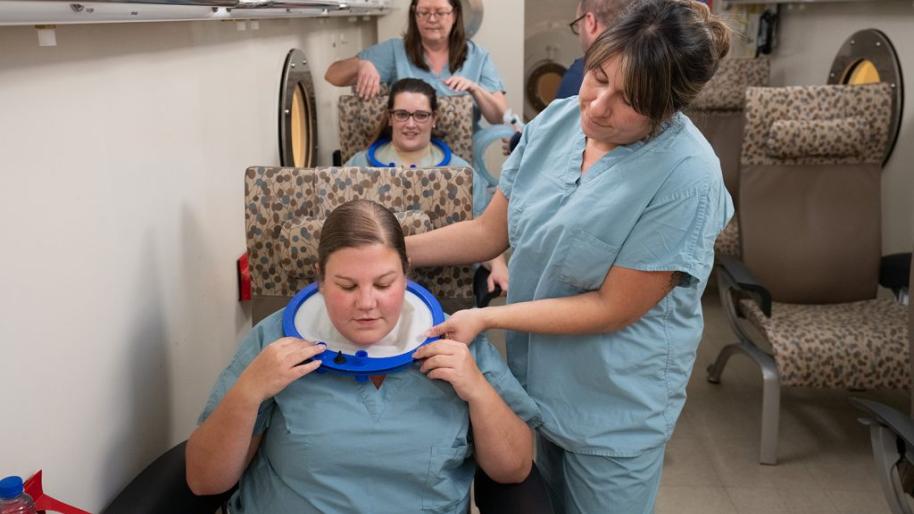Hyperbaric oxygen therapy is a treatment used to accelerate the healing of wounds and infections when tissues lack the oxygen required to heal. “Hyper” means ”increased” and “baric” refers to pressure.
Patients enter a room referred to as the hyperbaric chamber. In the chamber, patients are fitted with hoods. The chamber is pressurized, and the hoods allow patients to breathe 100% oxygen in this pressurized environment.
How does hyperbaric oxygen therapy work?
Breathing 100% oxygen inside the pressurized chamber dramatically increases the amount of oxygen in the bloodstream. This increased oxygen can help wounds and damaged tissues heal faster by building new blood vessels (angiogenesis), and can help eliminate some difficult infections.
What types of conditions can be treated with hyperbaric oxygen therapy?
Common conditions that can benefit from hyperbaric oxygen therapy include diabetic foot ulcers, stubborn bone infections (osteomyelitis), wounds that are struggling to heal after surgery, and tissues damaged by radiation therapy (radiation cystitis, osteoradionecrosis, and others). There are several other uncommon indications that might be considered for treatment; the full list is available here.
What is the chamber like?
U-M Health’s hyperbaric chamber is called a “multiplace chamber.” This means more than one person can be in the room (the chamber) at a time. We use a multiplace chamber to make sure that patients don’t feel claustrophobic or isolated. It is a comfortable -- even social -- environment. Patients are seated in large, comfortable leather chairs. Our chamber holds up to 10 patients per treatment. Due to social distancing requirements, our current capacity is reduced to 5 patients at a time
An attendant fits patients with specialized hoods, through which they will receive oxygen. While in the chamber, patients can read, watch TV, and change position. Standing up and moving around is permitted. An attendant is always available to monitor and address any patient needs.
How long do patients stay in the chamber?
Patients are in the chamber for approximately two hours per treatment. They spend 30 minutes with their hood on, then the hood is removed for 10 minutes. We repeat this cycle three times per treatment. Protocols for hood use may vary slightly to optimize patient safety while pandemic restrictions are in effect.
What should patients expect during treatment?
Patients will hear a hissing sound as the chamber is pressurized (descent). They may feel warm for a few minutes at the beginning. Similar to an airplane cabin, patients might feel pressure or squeezing in their ears, sinuses, or teeth. Ear pressure may be relieved by yawning, swallowing a sip of water, or chewing gum (water and gum are provided). Patients should tell the attendant if they notice pain in their ears or other areas.
When the pressure is released (acscent) at the end of the treatment, patients will feel cool. During ascent, ear symptoms are much less likely; patients can simply relax and breathe normally.
Are there side effects?
Some patients may experience problems with their ears due to the pressure changes. It is important to notify the attendant if you experience ear pain during treatment or between treatments. Vision changes can also occur in some patients, which might be due to changes in focal distance or cataracts. As with ear troubles, patients should notify an attendant or other medical professional if they notice their vision worsening during their treatment cycle.
While rare, some patients can experience seizures during treatment because of the high levels of oxygen. This is very uncommon with the safety precautions we have built into our treatment plans. Our chamber is continually monitored by our attendants to immediately identify and assist if any type of urgent medical situation arises.
Make an Appointment
Hyperbaric oxygen therapy is administered by the U-M Health Wound Care Clinic. Call the clinic at 734-936-9795 with questions regarding this therapy or for information on how to refer a potential patient.

